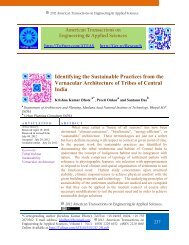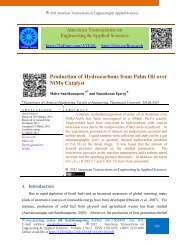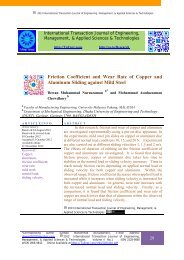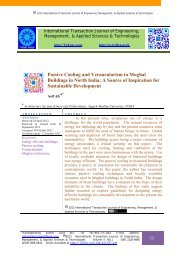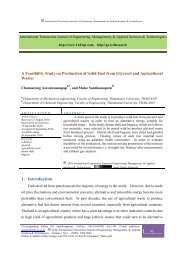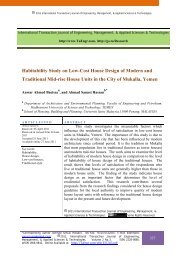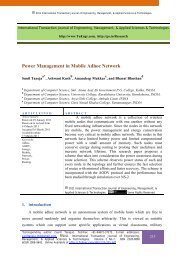A Study of Hole Drilling on Stainless Steel AISI 431 by EDM Using ...
A Study of Hole Drilling on Stainless Steel AISI 431 by EDM Using ...
A Study of Hole Drilling on Stainless Steel AISI 431 by EDM Using ...
You also want an ePaper? Increase the reach of your titles
YUMPU automatically turns print PDFs into web optimized ePapers that Google loves.
Figure 5(d) shows the phenomena <str<strong>on</strong>g>of</str<strong>on</strong>g> <strong>EDM</strong> drilling <strong>on</strong> shallow and deep holes (Yu et al. 2009).3.4 Analysis <str<strong>on</strong>g>of</str<strong>on</strong>g> Duty Factor and OnTimeThe duty factor, which means the ratio between pulse durati<strong>on</strong> and pulse cycle time exertsan important role <strong>on</strong> the performance <str<strong>on</strong>g>of</str<strong>on</strong>g> <strong>EDM</strong> as shown in Figure6 (a). In this experiment, wec<strong>on</strong>siderati<strong>on</strong> <str<strong>on</strong>g>of</str<strong>on</strong>g> each parameters <strong>by</strong> varying duty factor 10, 15, 20, 35, 45, 60, 75, 90 %, <strong>on</strong>time 10, 30, 50, 90 μs, and fixing parameters <str<strong>on</strong>g>of</str<strong>on</strong>g> current at 9 A, servo rate at 2 mm/sec, and waterpressure at 40 kg/cm 2 , respectively. As can be seen in Figure6 (b-c), the results were found thatthe each <strong>on</strong>-time was suitable for <strong>on</strong>ly a specific duty factor. MRR increases with increasing <str<strong>on</strong>g>of</str<strong>on</strong>g>duty factor <str<strong>on</strong>g>of</str<strong>on</strong>g> each <strong>on</strong>-time. However, increasing <str<strong>on</strong>g>of</str<strong>on</strong>g> duty factor leads to decreasing <str<strong>on</strong>g>of</str<strong>on</strong>g> EWR andtaper. Moreover, if increasing <str<strong>on</strong>g>of</str<strong>on</strong>g> <strong>on</strong>-time less than 30 µs, it still affects to MRR increases. At 75% <str<strong>on</strong>g>of</str<strong>on</strong>g> duty factor for <strong>on</strong>-time 30 and 50 µs, they give same values <str<strong>on</strong>g>of</str<strong>on</strong>g> MRR. However, theseparameters results in low EWR and taper.(a) Effect <str<strong>on</strong>g>of</str<strong>on</strong>g> servo rate with MRR(b) Effect <str<strong>on</strong>g>of</str<strong>on</strong>g> servo rate with EWR(c) Effect <str<strong>on</strong>g>of</str<strong>on</strong>g> servo rate with taper(d) Edge wear influence to high servo rateFigure 5: Variati<strong>on</strong>s <str<strong>on</strong>g>of</str<strong>on</strong>g> servo rate with meso-hole results.*Corresp<strong>on</strong>ding author (A. Muttamara). Tel/Fax: +66-2-5643001 Ext.3189. E-mail addresses:mapiwat@engr.tu.ac.th. 2011. Internati<strong>on</strong>al Transacti<strong>on</strong> Journal <str<strong>on</strong>g>of</str<strong>on</strong>g> Engineering,Management, & Applied Sciences & Technologies. Volume 2 No.4. ISSN 2228-9860.eISSN 1906-9642. Online Available at http://TuEngr.com/V02/471-481.pdf477



